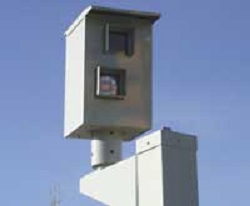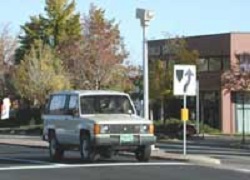Red Light Camera Enforcement
Boulder, Colorado
Prepared by Bill Cowern, Transportation Operations.
Boulder, Colorado
Prepared by Bill Cowern, Transportation Operations.
A high number of red light violation crashes were occurring at several city intersections.

Enforcement cameras are used for red light and speed enforcement.
Across the country, cities have begun to tackle the problem of red light running from a technological perspective. Red light running has been the cause of numerous fatal collisions involving motorists, passengers, bicyclists, and pedestrians. In fact, these collisions often have a higher chance of being fatal due to the fact that the running vehicles are more likely to be traveling at high speeds to race through the intersection. The City of Boulder began to address the issue in 1998 after recording a high number of collisions at some of the city's intersections.
Since August 1998, the city of Boulder has been using photo enforcement technology to enforce traffic laws and improve safety at a few designated signalized intersections. Camera housing costs between $10K and $20K depending on site specifics. The Cameras Rent for about $2,350 plus another $375 for field maintenance. The city program for red light running includes four photo red light cameras. The photo red light cameras have been in operation since August 1998.

An intersection with camera enforcement.
The photo red light cameras were initially located at the following intersections:
Two additional intersections were added in 2001:
In the thirty months since its inception, the program has demonstrated substantial benefit in the reduction of red light running at the four locations where it is currently deployed. In 1998, after implementation of photo red light cameras, there was an average of 69 violations daily. In 1999, there was a 9 percent reduction with an average of 62 daily red light violations. This improvement increased in 2000 with a 21 percent reduction from 1998 to 54 daily red light violations. The first quarter of 2001 shows further improvement with a 34 percent reduction from 1998 levels to an average of 45 daily violations. Table 1 summarizes these results.
| Year | Average Daily Red Light Violations | Percent Reduction since 1998 |
|---|---|---|
| 1998 | 69 | -- |
| 1999 | 62 | 9% |
| 2000 | 54 | 21% |
| 2001 | 45 | 34% |
Staff examined the collision history of intersection approaches using the photo red light technology. Prior to the cameras, the intersection approaches of westbound Valmont Road at 47th Street and westbound Table Mesa Drive at the Foothills Parkway off-ramp-RTD driveway both had significant collision rates associated with red light violations. Since the use of photo red light on these approaches began, the collision rates have dropped significantly at both locations. Table 2 details the average collision rates per year at these two intersection approaches before and after the use of photo red light technology.
| Intersection | Before Photo Red Light | After Photo Red Light | Difference (% Difference) |
|---|---|---|---|
| WB Valmont Road at 47th Street | 5.8 | 2.7 | -3.1 (-53.4%) |
| WB T.Mesa Drive at FHP off-ramp | 5.1 | 1.3 | -3.8 (-74.5%) |
The two intersection approaches listed in the table were chosen to have photo red light enforcement installed due to the high numbers of red light violation-related collisions that occurred there. At these two intersection approaches, red light violation collisions were reduced by between 50 percent and 75 percent. These findings are consistent with national findings on the collision reduction benefits of the photo red light technology.
The four approaches not listed in the table above are located at the intersection of 28th Street and Arapahoe Avenue and at the intersection of 29th Street and Canyon Boulevard. These approaches did not have a significant collision problem of this type prior to or during the use of the photo red light technology.
From the data presented here, the photo red light enforcement program had a significant effect of reducing the number of collisions caused by red light runners. This has a benefit to pedestrians who are more likely to sustain fatal injuries in these types of pedestrian/motor vehicle conflicts.
Bill Cowern
Transportation Operations Engineer
City of Boulder
PO Box 791, Boulder CO 80306
Phone: 303-441-3266
Fax: 303-441-4271
Email: CowernB@ci.boulder.co.us